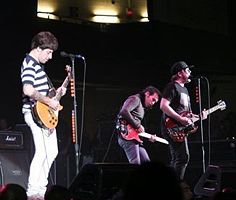Piano Sheets > Fall Out Boy Sheet Music > This Ain't A Scene, It's An Arms Race (ver. 1) Piano Sheet
This Ain't A Scene, It's An Arms Race (ver. 1) by Fall Out Boy - Piano Sheets and Free Sheet Music

About the Song
"This Ain't a Scene, It's an Arms Race" (also known as "This Ain't a Scene, It's a Goddamn Arms Race") is the first single from pop rock/pop punk/emo rock band Fall Out Boy's album Infinity on High. It was first played on November 16, 2006, on Indianapolis radio station, 93.1, and leaked onto the Internet soon after. It was officially debuted on November 21 at the American Music Awards and was shipped to radio stations that night (with an impact date of December 5 in the United States). This song was #42 on Rolling Stone's list of the 100 Best Songs of 2007.
The song is reportedly about lyricist/bassist Pete Wentz's frustration with the ever growing 'emo scene'. As he told Rolling Stone, "There may be other songs on the record that would be bigger radio hits, but this one had the right message." Wentz got the idea for the arms-dealer metaphor from the Lord of War movie.
The website that.
Download this sheet!
About the Artist

Random article
The essentials of piano sheet music Most people have the notion that sheet music is a very complicated notation and reading it very difficult. However, this is not true as understanding sheet music piano is just a matter of transcribing the various musical notes written.
Uses of sheet music
Piano sheet music is nothing but piano notes written in standard notations. You can avail such free sheet music online from various websites. The main use of sheet music piano is to help aspiring musicians recreate the same sequence of notes as performed by the composer of the piece. It is a method where a specific musical composition is recorded in written form using music notes. The ultimate aim of reading sheet music is to recreate the same score in as accurate a manner as is possible.
(More...)
